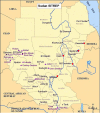A comparative study on the efficacy of artesunate plus sulphadoxine/pyrimethamine versus artemether-lumefantrine in eastern Sudan
- PMID: 17631681
- PMCID: PMC1940006
- DOI: 10.1186/1475-2875-6-92
A comparative study on the efficacy of artesunate plus sulphadoxine/pyrimethamine versus artemether-lumefantrine in eastern Sudan
Abstract
Background: A combination of artesunate (AS) plus sulphadoxine/pyrimethamine (SP) as first-line and artemether-lumefantrine (AL) as second-line treatment are currently recommended against uncomplicated P. falciparum infection in Sudan. However, there is limited information on the efficacy of ACTs in the country and only one report of PCR-corrected results for AS/SP only.
Methods: The WHO protocol for the assessment of antimalarial drug efficacy for the treatment of uncomplicated falciparum malaria was employed. Artesunate plus sulphadoxine/pyrimethamine (AS/SP) was compared to artemether-lumefantrine (AL) in a 28-day follow up. Samples that were classified as early treatment failure (ETF), late treatment failure (LCF) or late parasitological failure (LPF) were genotyped for msp-1 and msp-2 genes to differentiate recrudescence from reinfection.
Results: A total of 178 patients were screened and 160 met the enrollment criteria and were recruited to the study of which 157 (98.1%) completed the follow up and had an analysed treatment outcome. On the AS/SP arm, three (0.038%) patients were lost during the follow-up, two on day 1 and one on day 7, and 77 (96.3) completed the study, while all 80 (100%) patients completed the follow up in the AL arm. In the per protocol analysis for AS/SP the treatment outcome for patients who completed the follow-up were as follows: adequate clinical and parasitological response (ACPR); 84.4% ETF; 1.3%, LCF; 3.9%, (LPF); 10.4%. For the AL arm the out come was as follows, ACPR; 90%, ETF; 0%, LCF; 6.3% and LPF; 3.8%. However, when PCR-corrected, 6.5% (5/77) of patients treated with AS/SP maintained parasites from their primary infection, while (7/80) in the AL group maintained their initial parasite genotype. Therefore, PCR-corrected efficacy was 93.5% in the AS/SP treated group and for AL it was 91.3%.
Conclusion: Both AS/SP and AL are highly effective for the treatment of uncomplicated falciparum malaria in eastern Sudan. However, AS/SP appears to have a slightly higher efficacy than AL, this may be due to patient compliance with the repeated dose rather than drug efficacy.
Figures
Similar articles
-
Randomized comparison of chloroquine plus sulfadoxine-pyrimethamine versus artesunate plus mefloquine versus artemether-lumefantrine in the treatment of uncomplicated falciparum malaria in the Lao People's Democratic Republic.Clin Infect Dis. 2004 Oct 15;39(8):1139-47. doi: 10.1086/424512. Epub 2004 Sep 27. Clin Infect Dis. 2004. PMID: 15486837 Clinical Trial.
-
Therapeutic efficacy of artemether-lumefantrine for the treatment of uncomplicated Plasmodium falciparum malaria from three highly malarious states in India.Malar J. 2016 Oct 13;15(1):498. doi: 10.1186/s12936-016-1555-4. Malar J. 2016. PMID: 27737665 Free PMC article.
-
Efficacy and tolerability of four antimalarial combinations in the treatment of uncomplicated Plasmodium falciparum malaria in Senegal.Malar J. 2007 Jun 14;6:80. doi: 10.1186/1475-2875-6-80. Malar J. 2007. PMID: 17570848 Free PMC article. Clinical Trial.
-
[Combined antimalarial therapy using artemisinin].Parassitologia. 2004 Jun;46(1-2):85-7. Parassitologia. 2004. PMID: 15305693 Review. Italian.
-
Coartemether (artemether and lumefantrine): an oral antimalarial drug.Expert Rev Anti Infect Ther. 2004 Apr;2(2):181-96. doi: 10.1586/14787210.2.2.181. Expert Rev Anti Infect Ther. 2004. PMID: 15482185 Review.
Cited by
-
Descriptive study on the efficacy of artemether-lumefantrine in the treatment of uncomplicated Plasmodium falciparum malaria in Sudan.Eur J Clin Pharmacol. 2010 Mar;66(3):231-7. doi: 10.1007/s00228-009-0750-4. Eur J Clin Pharmacol. 2010. PMID: 20187287 Clinical Trial.
-
Increased pfmdr1 copy number and sequence polymorphisms in Plasmodium falciparum isolates from Sudanese malaria patients treated with artemether-lumefantrine.Antimicrob Agents Chemother. 2011 Nov;55(11):5408-11. doi: 10.1128/AAC.05102-11. Epub 2011 Sep 6. Antimicrob Agents Chemother. 2011. PMID: 21896916 Free PMC article.
-
Malaria: uncomplicated, caused by Plasmodium falciparum.BMJ Clin Evid. 2007 Oct 1;2007:0919. BMJ Clin Evid. 2007. PMID: 19450360 Free PMC article.
-
Artemisinin derivatives for treatment of uncomplicated Plasmodium falciparum malaria in Sudan: too early for too much hope.Parasitol Res. 2010 Feb;106(3):549-52. doi: 10.1007/s00436-009-1700-x. Epub 2009 Dec 15. Parasitol Res. 2010. PMID: 20012990 Review.
-
Protective efficacy of malaria case management and intermittent preventive treatment for preventing malaria mortality in children: a systematic review for the Lives Saved Tool.BMC Public Health. 2011 Apr 13;11 Suppl 3(Suppl 3):S14. doi: 10.1186/1471-2458-11-S3-S14. BMC Public Health. 2011. PMID: 21501431 Free PMC article.
References
-
- Malik EM., O.M., Khalafalla Malaria in Sudan: past, present and the future. Gezira Journal of Health Sciences. 2004;1:47–51.
-
- Babiker HA, Pringle SJ, Abdel-Muhsin A, Mackinnon M, Hunt P, Walliker D. High-level chloroquine resistance in Sudanese isolates of Plasmodium falciparum is associated with mutations in the chloroquine resistance transporter gene pfcrt and the multidrug resistance Gene pfmdr1. J Infect Dis. 2001;183:1535–1538. doi: 10.1086/320195. - DOI - PubMed
-
- Adam I EMI. Resistance of P. falciparum to antimalarial drugs in Sudan. Khartoum Med J. 2005.
-
- Salah MT, Mohammed MM, Himeidan YE, Malik EM, Elbashir MI, Adam I. A randomized comparison of sulphadoxine-pyrimethamine and combination of sulphadoxine pyrimethamine with chloroquine in the treatment of uncomplicated falciparum malaria in Eastern Sudan. Saudi Med J. 2005;26:147–148. - PubMed
Publication types
MeSH terms
Substances
LinkOut - more resources
Full Text Sources
Medical
Research Materials
Miscellaneous


